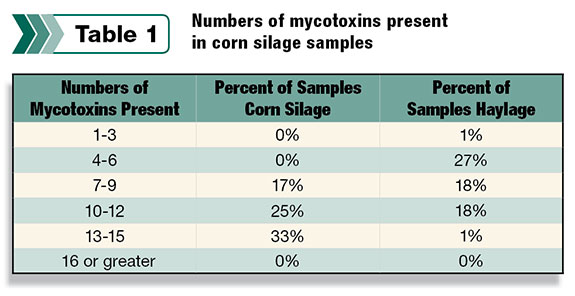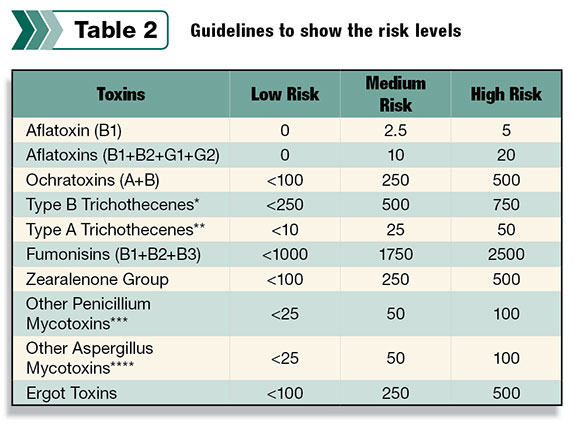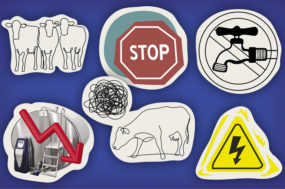Now, as many dairy producers have found in the first six months of 2013, the 2012 corn crop has created issues in maintaining cow health and performance.
Dairy producers are finding more than just one particular toxin in their feedbunks this summer, with recent test results showing an increase in fusarium mycotoxins.
It is important to understand that mycotoxins can be produced on the crops in the field as well as during storage. Deoxynivalenol (DON or vomitoxin) and zearalenone are the most common fusarium mycotoxins and are considered field toxins.
In addition, toxins can be produced in storage, which are a result from penicillium moulds and include patulin, requefortine C, mycophenolic acid, penicillic acid and PR toxins.
Moulds will grow off of the nutrients in the feed, whether corn silage or haylage, decrease the nutrient quality of the feed, and to survive, create an environment or “niche” by producing toxins.
Multiple mycotoxins can pose a threat due to their ability to work in either an additive or synergistic manner. Additive is merely a summation of toxicity, but mycotoxins that act synergistically will magnify the effects of other mycotoxins and therefore magnify the negative impact on cow performance and health.
For example, according to one set of researchers, DON and fumonisin B1 can have an additive interaction, whereas another set of researchers found DON and fusaric acid to be synergistic.
It appears that some mycotoxins can bind with other feed materials such as glucose and are able to escape analytical methods used to determine the mycotoxin concentrations.
These are referred to as “masked mycotoxins.” This glucose bond, however, is easily broken within the animal’s digestive system via hydrolysis, and the mycotoxin is still harmful to the cow. This often means the mycotoxin test results are underestimated.
Mycotoxin management programs emphasize that dairy producers begin to concentrate on the total amount of mycotoxins given to the cows on a daily basis and not what is in a particular feed ingredient.
A summary of the samples in an analysis ran on corn silage samples submitted from all over Canada are shown in Table 1.
Looking at the total amount of mycotoxins present gives a much more accurate picture of the challenge to the cows rather than just looking at the analysis of one or two mycotoxins.
When a sample contains high risk threats of total aflatoxins, type B trichothecenes and type A trichothecenes, individually, these toxins pose a threat, but together they pose a serious challenge to cow health and performance.
Symptoms may be decreased dry matter intake, lower milk production, diarrhea, gut hemorrhage, lower reproductive efficiency or abortion and higher incidence of secondary infections. Penicillium toxins can create more challenges by impacting rumen function.
When considering the total mycotoxins present, you now have a high risk threat to cow health, performance and immune status. Some producers may not consider that these high risk levels can cause a “crash” in production, but these levels can result in severe drops in milk production, reproduction and cow health over time.
Risk levels for each group of mycotoxins are shown in Table 2.
Both fusaric acid and fumonisins are fusarium mycotoxins and are often found in very high concentrations compared with vomitoxin, (otherwise known as deoxynivalenol or DON), zearalenone and some of the other fusarium mycotoxins.
The strain of fusarium fungus that is a major producer of fumonisin is also a major producer of fusaric acid.
According to Dr. Trevor Smith, University of Guelph, the significance of fumonisin in dairy feeds relates mainly to the fact that fumonisins are immunosuppressive.
They can cause lingering health problems in the herd – as animals do not respond to medications, vaccination programs fail and mortalities increase.
The liver is the major organ affected by fumonisins in dairy cattle. Fusaric acid causes low blood pressure, resulting in swelling of the feet and udder. Fusaric acid is also immunosuppressive.
In addition to this, fusaric acid increases the toxicity of DON, causing reduced feed intake, loss of muscle coordination and lethargy.
“Both fumonisin and fusaric acid have been shown to also exist in masked (conjugated) forms which are non-detectable,” Smith says. “This implies that the 37+ analysis is actually an underestimate of these mycotoxins, and the potential threat is even greater that it seems.”
Mycotoxin management programs encourage the use of mycotoxin analysis to get a broader picture of the total mycotoxin challenge. Producers are encouraged to implement a mycotoxin control program to reduce the threat to cow health and performance.
In terms of the 2013 crop outlook, the wet weather in western Canada, and the hot, humid and even some very wet areas in Ontario are already having an effect. This is the time to be proactive. Consider using a mycotoxin management program to monitor and finish out the 2012 crop and be vigilant with the status of the 2013 crop as harvest begins this season. PD
Anita Heeg is a dairy specialist with Alltech Ontario and has been with the company for six years. She graduated from the University of Guelph with an animal biology degree.
References omitted due to space but are available upon request. Click here to email an editor.

- Anita Heeg
- Dairy Specialist
- Alltech Canada









